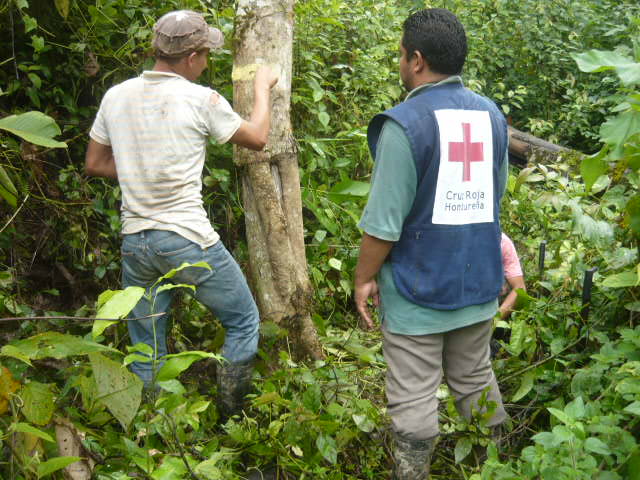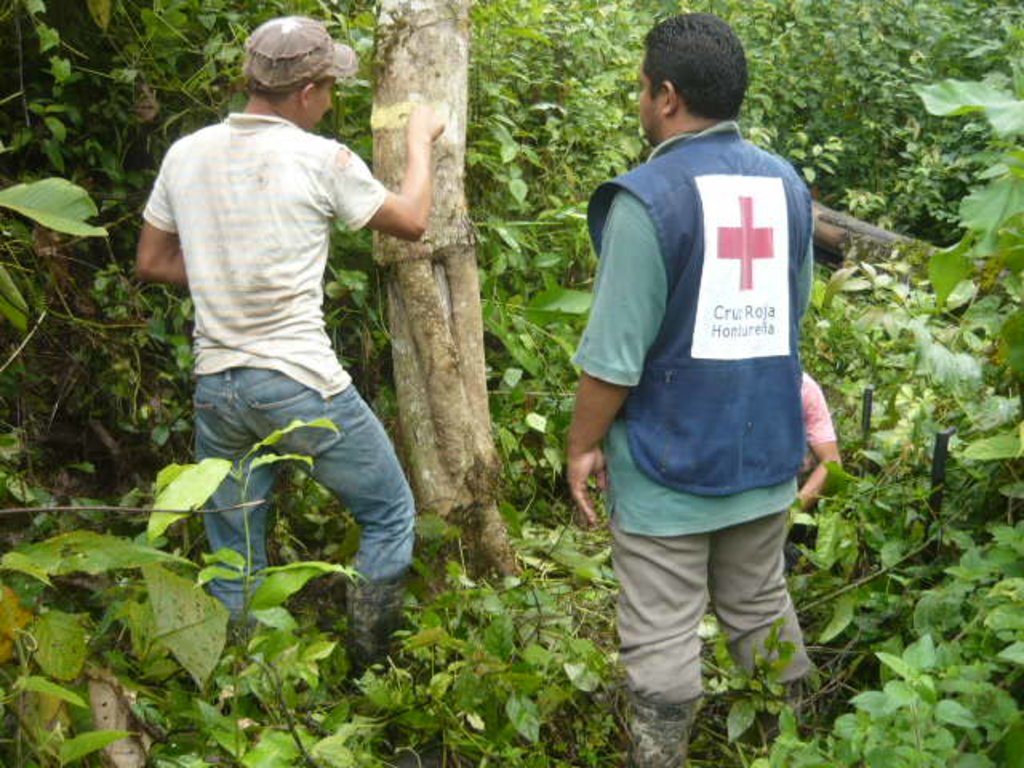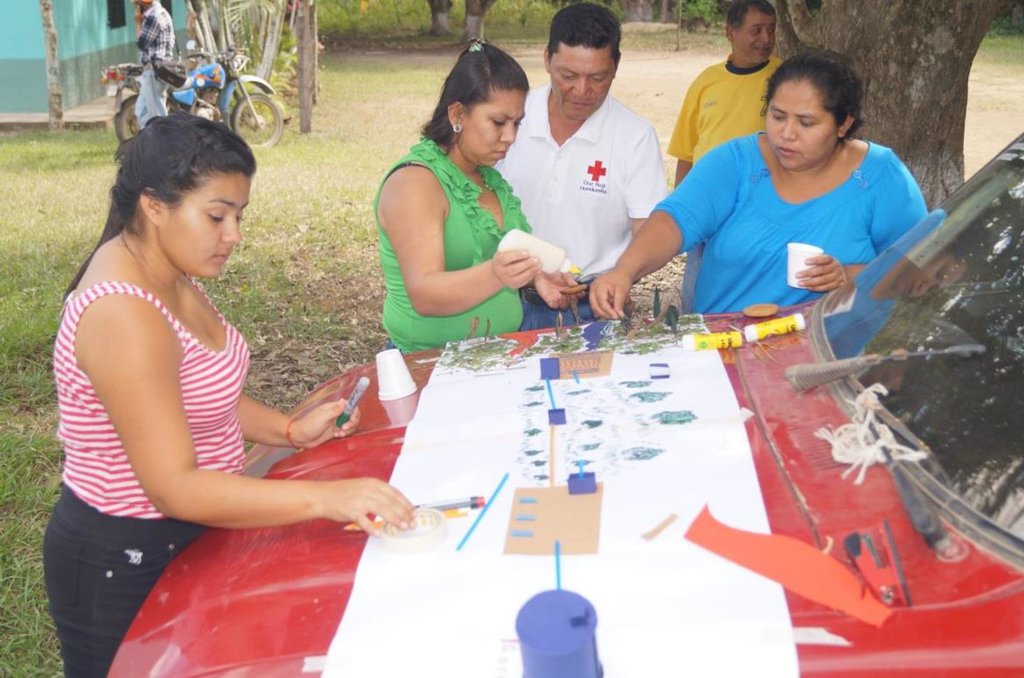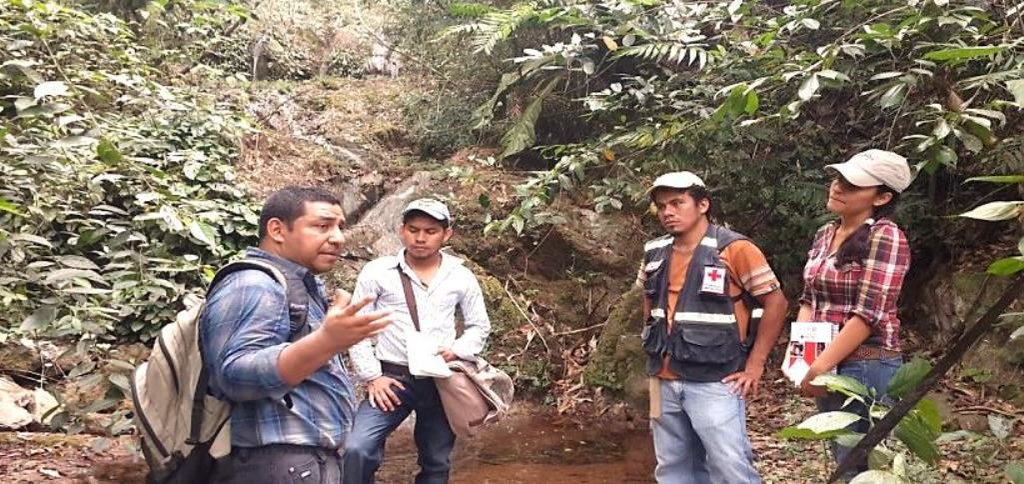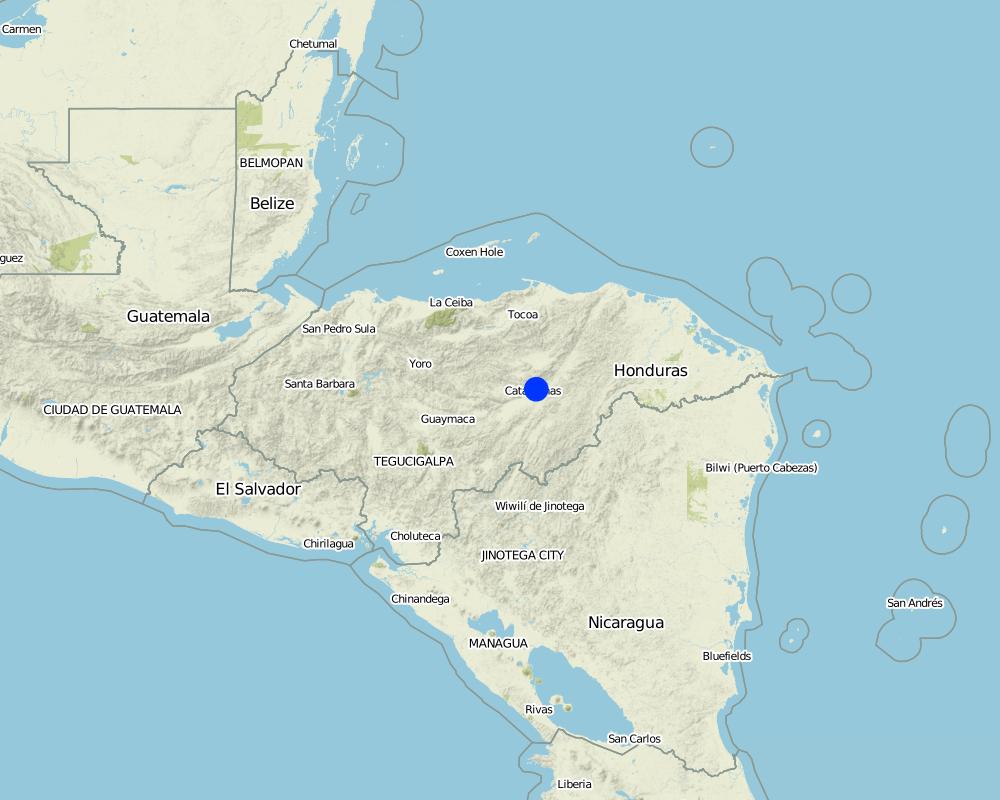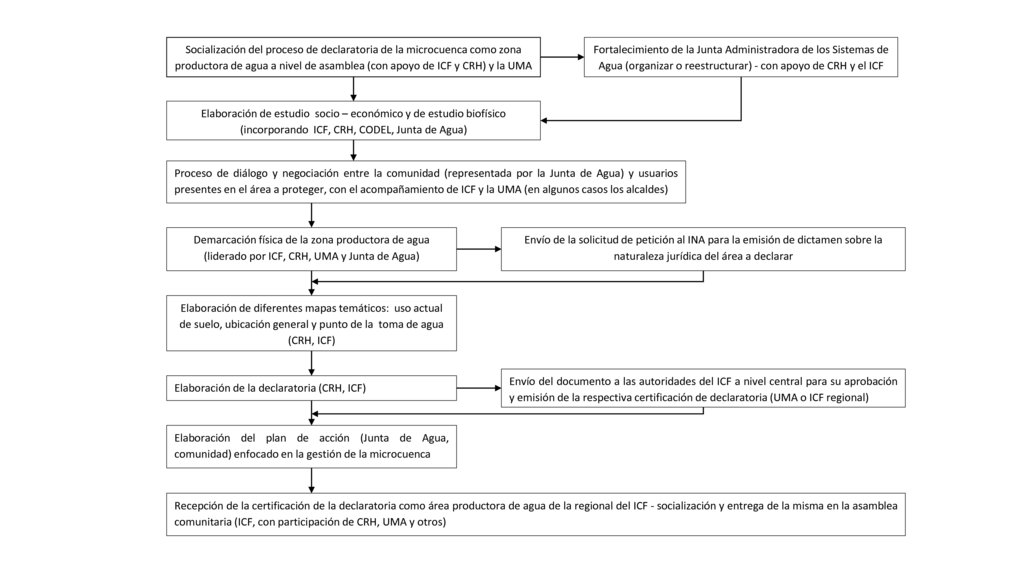Issuing a Decree to Ensure the Legal Protection of a microbasin [Honduras]
- Creation:
- Update:
- Compiler: Helen Gambon
- Editor: Anton Jöhr
- Reviewers: Johanna Jacobi, Alexandra Gavilano
Declaratoria (Issuing a Decree to ensure Legal Protection)
approaches_752 - Honduras
View sections
Expand all Collapse all1. General information
1.2 Contact details of resource persons and institutions involved in the assessment and documentation of the Approach
Key resource person(s)
land user:
Escalante Beltrán Trinidad
Key reference people for technologies related to approach
Pisijire, Dulce Nombre de Culmí municipality and y Jamasquire, Municipality of Catacamas, Olancho
Honduras
SLM specialist:
Montes Lobo Carlos
Honduran / Swiss Red Cross
In Honduras: Swiss Red Cross Office, Catacamas. Contact: Claudio Stauffer, Country coordinator In Switzerland: Cruz Roja Suiza, Werkstrasse 18, 3084 Wabern. Contact: Grégoire Labhardt, Head of Program
Honduras
SLM specialist:
Acosta Granados Nelin Lorena
Honduran / Swiss Red Cross
In Honduras: Swiss Red Cross Office, Catacamas. Contact: Claudio Stauffer, Country coordinator In Switzerland: Cruz Roja Suiza, Werkstrasse 18, 3084 Wabern. Contact: Grégoire Labhardt, Head of Program
Honduras
land user:
Acosta Granados Nelin Lorena
Honduran / Swiss Red Cross
In Honduras: Swiss Red Cross Office, Catacamas. Contact: Claudio Stauffer, Country coordinator In Switzerland: Cruz Roja Suiza, Werkstrasse 18, 3084 Wabern. Contact: Grégoire Labhardt, Head of Program
Honduras
land user:
Acosta Granados Nelin Lorena
Honduran / Swiss Red Cross
In Honduras: Swiss Red Cross Office, Catacamas. Contact: Claudio Stauffer, Country coordinator In Switzerland: Cruz Roja Suiza, Werkstrasse 18, 3084 Wabern. Contact: Grégoire Labhardt, Head of Program
Honduras
Name of project which facilitated the documentation/ evaluation of the Approach (if relevant)
Book project: where people and their land are safer - A Compendium of Good Practices in Disaster Risk Reduction (DRR) (where people and their land are safer)Name of the institution(s) which facilitated the documentation/ evaluation of the Approach (if relevant)
Swiss Red Cross (Swiss Red Cross) - Switzerland1.3 Conditions regarding the use of data documented through WOCAT
When were the data compiled (in the field)?
22/11/2016
The compiler and key resource person(s) accept the conditions regarding the use of data documented through WOCAT:
Yes
1.4 Reference(s) to Questionnaire(s) on SLM Technologies
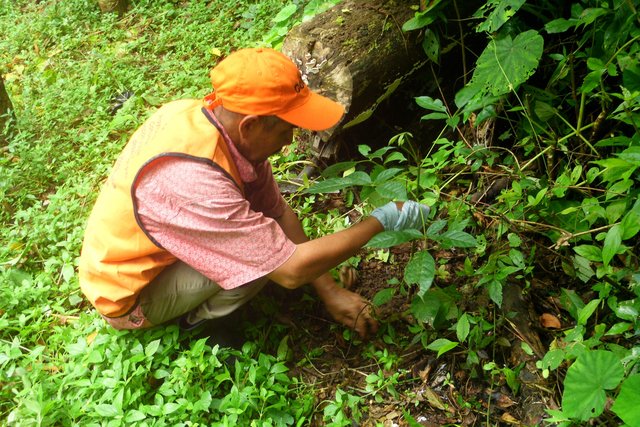
Community protection of microbasins through reforestation [Honduras]
Microbasins providing drinking water to many communities frequently suffer from deforestation and are used as grazing areas, for coffee production areas or for other types of crops. As a whole, communities choose to protect microbasins and ensure reforestation resorting to legal protection, thus ensuring the quantity and quality of their …
- Compiler: Helen Gambon
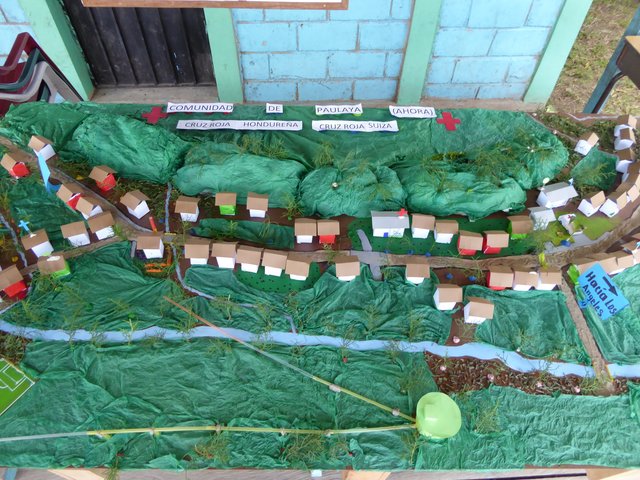
Community protection of water infrastructure from hazards caused … [Honduras]
A series of vegetative, structural and management technologies is used reduce the exposure and vulnerability of water infrastructure to threats. These include protecting water sources and water tanks, the stabilization of their surroundings, the anchoring of piping and, whenever necessary, repairing the water tank.
- Compiler: Helen Gambon
2. Description of the SLM Approach
2.1 Short description of the Approach
Honduran Forest Legislation establishes the strict protection of microbasins from human exploitation. However, in practice, there is an accelerated rate of microbasin degradation brought on by land use changes that turn forest lands into crop lands. Through sensitization, raising awareness, and training aimed at the general population and Water Management Boards, Local Emergency Committees (in Spanish, Comités de Emergencia Local, CODEL) and Health Committees in particular, a negotiation process involving land users is promoted to protect microbasins that provide water by issuing a decree.
2.2 Detailed description of the Approach
Detailed description of the Approach:
One of the main obstacles faced by communities in the Department of Olancho, Honduras, is access to water systems providing water in the required quantities and quality. In recent years, inadequate use of these microbasins has increased erosion in these regions. Changes in land use resulting in transforming forest lands into lands for agricultural and livestock production affect the cycle for recharging water. Furthermore, the pollution caused by agrochemicals and waste water derived from coffee processing reduces water quality and damages the health of the area's population
Honduran forest legislation establishes strict protections for microbasins exploited for human consumption. However, enforcing these laws frequently causes conflicts. The “Resiliencia” project headed by the Honduran / Swiss Red Cross, together with competent authorities, supports issuing decrees in order to protect microbasins; this is based on sensitization, raising awareness and providing training to the general population, specifically at the Water Management Boards, Local Emergency Committees (CODEL) and Health Committees. Local structures led by Water Management Boards are the main actors in this process and participate in community assemblies, surveys, delimitation of microbasins, collection of documents and negotiation with users, etc.
During the negotiation process, many Water Management Boards have carried out diverse fund-raising activities to compensate those users who give up the land plots they use in the microbasin. The Forest Conservation Institute (in Spanish, Instituto de Conservación Forestal, ICF) and the Environmental Municipal Unit (In Spanish, Unidad Municipal Ambiental, UMA) as well as the Red Cross, help to collect data, to define the area that will come under protection, to draft theme maps, to consolidate information required for clearance by the National Agrarian Institute (in Spanish, Nacional Agrario, INA). This also facilitates negotiations and agreements with people exploiting the aforementioned areas. The process required to issue a decree increases the community's sense of property, as well as ensures protection and conservation of microbasins and comprehensive water management systems. The nucleus of the approach involves strengthening Water Management Boards to help them manage their own water system through training in environmental issues, management and fee estimation, as well as providing them with tools to improve their water provision system. Thus, Water Management Boards become key players in protecting microbasins.
2.3 Photos of the Approach
2.5 Country/ region/ locations where the Approach has been applied
Country:
Honduras
Region/ State/ Province:
Olancho
Further specification of location:
Dulce Nombre de Culmí, San Esteban and Catacamas municipalities
Map
×2.6 Dates of initiation and termination of the Approach
Indicate year of initiation:
2011
Comments:
The process to issue decrees to provide protection to microbasins started in 1987. Political instability and changes in the ministries in charge resulted in many of these decrees never being enacted. In 2011 the Honduran/ Swiss Red Cross started to support and provide technical aid to communities to further this process.
2.7 Type of Approach
- recent local initiative/ innovative
2.8 Main aims/ objectives of the Approach
Strengthen community capacities, specifically Water Management Boards leading the process, to ensure decrees are issued and strict protection measures are decreed in favor of microbasins to allow recharging underground water and ensure water quality and quantity.
2.9 Conditions enabling or hindering implementation of the Technology/ Technologies applied under the Approach
availability/ access to financial resources and services
- enabling
Fundraising activities undertaken by Water Management Boards compensated land users in areas that required reforestation/protection. In other cases, they also allowed buying additional plots for the community to expand protected areas.
- hindering
Human needs lead to improper use of land and to expand the agrarian
border into areas that are not apt for production. Scarce resources for municipal governments and short-term thinking in water management hinder investments in water infrastructure. The approach aims at addressing this issue.
institutional setting
- enabling
The process to issue decrees for protection is a highly concerted effort involving competent authorities and local structures
collaboration/ coordination of actors
- enabling
Coordination and cooperation among all actors involved is very important for comprehensive water management aimed at reducing disasters
legal framework (land tenure, land and water use rights)
- enabling
Honduran legislation sets forth a legal basis to implement the technologies described in the approach and constitutes the basis of the approach itself.
policies
- hindering
Political instability and changes in competent government institutions and entities in the past years have resulted in delaying the decrees required to protect microbasins. The Red Cross Project supports communities in their follow-up efforts to issue the aforementioned decrees.
knowledge about SLM, access to technical support
- enabling
The project has facilitated the implementation of SLM Technologies by raising awareness and training as well as technical support,
workload, availability of manpower
- enabling
A signifcant amount of labor is required to implement SLM Technologies. The
interest demonstrated by the population in protecting their microbasin was crucial to provide significant amounts of volunteer labor.
3. Participation and roles of stakeholders involved
3.1 Stakeholders involved in the Approach and their roles
- community-based organizations
Water Management Committees
Local Emergency Committees (Comités de Emergencia Local, CODEL)
Health Committees
Leadership for the process required to issue decrees to protect microbasins
Implementing reforestation
activities and microbasin protection
Follow-up efforts to ensure water quality
- NGO
Honduran/ Swiss Red Cross
Sensitize, raise awareness, train, facilitate negotiations support data collection efforts and follow-up activities focused on the process, technical and material support to implement SLM technologies
- local government
Institute for the Conservation of Forests (Instituto de Conservación Forestal, ICF regional)
Municipal Environmental Units (Unidades Municipales Ambientales, UMA
ICF: Facilitate negotiations, support data collection efforts and follow up activities, submit the Decree
UMA: Disseminate the process, facilitate negotiations, provide support in delimitation
- national government (planners, decision-makers)
Institute for Forest Conservation (Instituto de Conservación Forestal, ICF nacional)
National Agrarian Institute (Instituto Nacional Agrario, INA)
ICF: Approve and issue corresponding certification for protection decree
INA: Ruling on legal nature of the area addressed in the decree (proof of land property)
If several stakeholders were involved, indicate lead agency:
Community organizations (Water Management Boards)
3.2 Involvement of local land users/ local communities in the different phases of the Approach
| Involvement of local land users/ local communities | Specify who was involved and describe activities | |
|---|---|---|
| initiation/ motivation | interactive | |
| planning | interactive | |
| implementation | interactive | |
| monitoring/ evaluation | interactive |
3.3 Flow chart (if available)
Description:
Abbreviations:
CRH - Honduran Red Cross
ICF - Institute for Forest Conservation (Instituto de Conservación Forestal)
CODEL - Local Emergency Committee (Comité de Emergencia Local)
INA - National Agrarian Institute (Instituto Nacional Agrario )
UMA - Municipal Environmental Unit (Unidad Municipal del Ambiente )
Author:
Carlos Montes Lobo, Honduran/ Swiss Red Cross
3.4 Decision-making on the selection of SLM Technology/ Technologies
Specify who decided on the selection of the Technology/ Technologies to be implemented:
- mainly land users, supported by SLM specialists
Specify on what basis decisions were made:
- evaluation of well-documented SLM knowledge (evidence-based decision-making)
- research findings
- personal experience and opinions (undocumented)
4. Technical support, capacity building, and knowledge management
4.1 Capacity building/ training
Was training provided to land users/ other stakeholders?
Yes
Specify who was trained:
- land users
- Water Management Boards
Form of training:
- courses
Form of training:
- asambleas comunitarias
Subjects covered:
Comprehensive Water System Management: Management, fee estimation, risk management, reforestation, water cycle, water treatment, drafting of action plans, developing requests for microprojects
4.2 Advisory service
Do land users have access to an advisory service?
Yes
- Water Management Board headquarters
4.3 Institution strengthening (organizational development)
Have institutions been established or strengthened through the Approach?
- yes, greatly
Specify the level(s) at which institutions have been strengthened or established:
- local
Describe institution, roles and responsibilities, members, etc.
Water Management Boards are responsible for managing the water system. It is composed of members of the community.
Specify type of support:
- capacity building/ training
- equipment
4.4 Monitoring and evaluation
Is monitoring and evaluation part of the Approach?
Yes
Comments:
Monitoring and assessment are part of the project cycle of Honduran/ Swiss Red Cross. Water Management Boards monitor water systems and reforested land plots, while the general population self-assesses resilience to disaster and health hazards.
If yes, is this documentation intended to be used for monitoring and evaluation?
No
4.5 Research
Was research part of the Approach?
Yes
Specify topics:
- sociology
- economics / marketing
- ecology
Give further details and indicate who did the research:
Biophysical studies of the microbasin and socioeconomic studies of the microbasin performed by CRH, ICF, UMA, with participation from local institutions.
5. Financing and external material support
5.1 Annual budget for the SLM component of the Approach
Indicate the annual budget for the SLM component of the Approach in US$:
18000.00
If precise annual budget is not known, indicate range:
- 10,000-100,000
Comments (e.g. main sources of funding/ major donors):
Swiss Red Cross
5.2 Financial/ material support provided to land users
Did land users receive financial/ material support for implementing the Technology/ Technologies?
Yes
If yes, specify type(s) of support, conditions, and provider(s):
Communities received material and tools to perform maintenance activities on the water system.
5.3 Subsidies for specific inputs (including labour)
- none
If labour by land users was a substantial input, was it:
- voluntary
5.4 Credit
Was credit provided under the Approach for SLM activities?
No
5.5 Other incentives or instruments
Were other incentives or instruments used to promote implementation of SLM Technologies?
No
6. Impact analysis and concluding statements
6.1 Impacts of the Approach
Did the Approach empower local land users, improve stakeholder participation?
- No
- Yes, little
- Yes, moderately
- Yes, greatly
The approach particularly empowered the Water Management Boards and linked them with relevant government entities and institutions, thus improving stakeholder involvement.
Did the Approach help land users to implement and maintain SLM Technologies?
- No
- Yes, little
- Yes, moderately
- Yes, greatly
The approach set the bases on which trained community institutions were able to implement and maintain SLM technologies.
Did the Approach mobilize/ improve access to financial resources for SLM implementation?
- No
- Yes, little
- Yes, moderately
- Yes, greatly
Part of the approach involves training on fund management and applying to financial resources for developing microprojects.
Did the Approach improve knowledge and capacities of land users to implement SLM?
- No
- Yes, little
- Yes, moderately
- Yes, greatly
Water Management Boards and Local Emergency Committees (CODEL) significantly increased their knowledge and capacities and, to a certain degree, are able to implement SLM independently. However, technologies such as reforestation or upgrading the water tank involves specific knowledge requiring technical support.
Did the Approach build/ strengthen institutions, collaboration between stakeholders?
- No
- Yes, little
- Yes, moderately
- Yes, greatly
The approach strengthened community institutions, specifically Water Management Boards and cooperation among involved stakeholders and institutions.
Did the Approach mitigate conflicts?
- No
- Yes, little
- Yes, moderately
- Yes, greatly
Evicting land users settled in the microbasin can potentially lead to many conflicts. The approach emphatizes dialogue among communities and land users in the microbasins to reach common agreements on the protection of these lands.
Did the Approach encourage young people/ the next generation of land users to engage in SLM?
- No
- Yes, little
- Yes, moderately
- Yes, greatly
The approach includes training on environmental issues in schools and involves students and teachers to implement SLM Technologies, such as reforestation.
Did the Approach improve issues of land tenure/ user rights that hindered implementation of SLM Technologies?
- No
- Yes, little
- Yes, moderately
- Yes, greatly
The approach enabled enacting Honduran Legislation to provide strict protection to microbasins, by reaching an agreement with users who hindered the implementation of SLM Technologies.
Did the Approach improve the capacity of the land users to adapt to climate changes/ extremes and mitigate climate related disasters?
- No
- Yes, little
- Yes, moderately
- Yes, greatly
Some water sources that had been dry for years are showing increased levels of water
Did the Approach lead to employment, income opportunities?
- No
- Yes, little
- Yes, moderately
- Yes, greatly
Some communities relying on the approach managed to increase the amount of water available and have started microprojects involving fish farming and installation of micro-irrigation systems.
Did the approach improve land users' health?
- No
- Yes, little
- Yes, moderately
- Yes, greatly
Strict protection of microbasins and improvement of water infrastructure reduced the contamination of water sources, thus reducing the incidence of diarrhea in the communities
6.2 Main motivation of land users to implement SLM
- reduced land degradation
- reduced risk of disasters
- enhanced SLM knowledge and skills
- conflict mitigation
- increase of quantity and quality of water
6.3 Sustainability of Approach activities
Can the land users sustain what has been implemented through the Approach (without external support)?
- uncertain
If no or uncertain, specify and comment:
Community structures have considerably increased their capacity to sustain and replicate the implementation of the approach. Two challenges threatening the sustainability of the approach are political instability and changes in government institutions and entities. These can bring the process to a standstill.
6.4 Strengths/ advantages of the Approach
| Strengths/ advantages/ opportunities in the land user’s view |
|---|
| Issuing the decree is a specific action that can provide the community with the required support to deal with intruders and implement microbasin protection measures. |
| Strengths/ advantages/ opportunities in the compiler’s or other key resource person’s view |
|---|
| The approach raised awareness among the population and provided training to the Water Management Boards to allow them considering and managing the water system based on a comprehensive approach. |
6.5 Weaknesses/ disadvantages of the Approach and ways of overcoming them
| Weaknesses/ disadvantages/ risks in the compiler’s or other key resource person’s view | How can they be overcome? |
|---|---|
| Sometimes it is not possible to reach an agreement and, thus, the community can forcefully evict land users who settled in the microbasin's territory. This can lead to open conflicts that, in a context as delicate as Honduras, can become violent. | Forced eviction must be the final resource. Close monitoring of this situation is required and dialogues must be established between the people affected and the community. |
7. References and links
7.1 Methods/ sources of information
- field visits, field surveys
1
- interviews with land users
3
- interviews with SLM specialists/ experts
1
- compilation from reports and other existing documentation
2
7.2 References to available publications
Title, author, year, ISBN:
Respuestas locales y desafíos globales: Reducción de riesgos desde la comunidad. Sistematización de los proyectos desarrollados del 2005 al 2014 en seis municipios de los departamentos de Olancho, Valle y Choluteca, Honduras. Cruz Roja Suiza, 2016
Available from where? Costs?
info@redcross.ch (gratis)
Title, author, year, ISBN:
Guía metodológica #7: Protección de microcuencas. Cruz Roja Suiza (a publicarse)
Links and modules
Expand all Collapse allLinks

Community protection of microbasins through reforestation [Honduras]
Microbasins providing drinking water to many communities frequently suffer from deforestation and are used as grazing areas, for coffee production areas or for other types of crops. As a whole, communities choose to protect microbasins and ensure reforestation resorting to legal protection, thus ensuring the quantity and quality of their …
- Compiler: Helen Gambon

Community protection of water infrastructure from hazards caused … [Honduras]
A series of vegetative, structural and management technologies is used reduce the exposure and vulnerability of water infrastructure to threats. These include protecting water sources and water tanks, the stabilization of their surroundings, the anchoring of piping and, whenever necessary, repairing the water tank.
- Compiler: Helen Gambon
Modules
No modules


